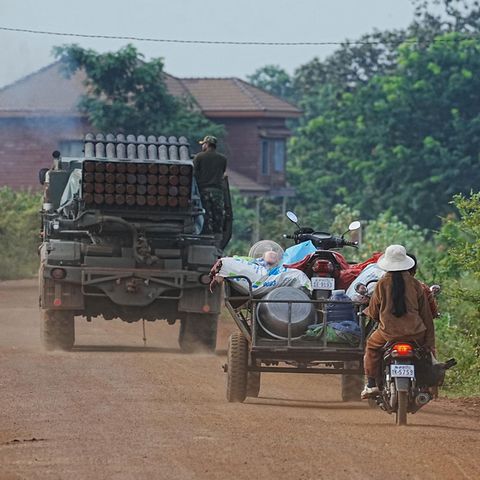conflict
Waffenruhe between Thailand and Cambodia in force – accusation of the break
Copy the current link
Add to the memorial list
Since the night, the weapons are supposed to be silent on the border between Thailand and Cambodia. But does the fire break last? Thailand raises accusations against the neighboring country.
The ceasefire agreed in the border conflict between Thailand and Cambodia came into force at midnight (local time). According to reports, the heavy battles in the border region initially stopped. In the morning, however, the Thai army reported violations of the Agreement on the part of the Cambodian side.
“At the time of the agreement of the agreement, the Thai side found that Cambodian armed forces had started armed attacks on several areas within the Thai territorial area,” said the spokesman for the Thai Army, Winthai Suware, on Tuesday. This represents a “intentional violation of the agreement” and is a clear attempt to “undermine the mutual trust,” added the speaker. “Thailand is forced to react accordingly and to exercise his legitimate right to self -defense,” he emphasized.
According to the Ministry of Defense Cambodia, on the other hand, it remained calm on the border. “The situation on the front has relaxed at midnight since the ceasefire,” said the Cambodian Prime Minister Hun Manet on Facebook on Tuesday morning.
The heads of government of the two Southeast Asian neighbors agreed on Monday at a meeting in Malaysia on an “immediate and unconditional” ceasefire. Representatives from the United States and China also took part in the discussions headed by the Malaysian Prime Minister Anwar Ibrahim. Malaysia is the chair of the Southeast Asian community of Asean this year.
Conflict between Thailand and Cambodia: Meeting of military leaders postponed
In the early morning, military leaders of both countries should meet for talks. The planned meeting was then postponed by several hours. Details about the reasons were not known.
On Thursday, heavy battles broke out on their more than 800 kilometers long border. According to official information, at least 38 people were killed. According to Bangkok, eleven soldiers and 14 civilians were killed on the Thai side. Phnom Penh confirmed the death of eight civilians and five soldiers.
More than 200,000 people were driven out of their place of residence. Both sides accuse themselves of triggering violence. What exactly led to the escalation is still unclear.
The battles were the latest escalation in a dispute over the border in the so-called emerald triangle for decades, where the Thai province of Surin and the Cambodian province of Oddar Meanchey and the neighboring state of Laos are bordered.
Before the meeting in Malaysia between Cambodia Prime Minister Hun Manet and Thailand’s head of the Federal Prime Minister Phumtham Wechayachai, international pressure had grown. US President Donald Trump has personally intervened in the escalating dispute since the weekend and called for a quick ceasefire with both heads of the government on phone calls.
Trump sees himself as “President of Peace”
Trump threatened that there would be no negotiations regarding his threatened tariffs as long as it would be fought. Previously, the US President had announced that it was 36 percent of the two countries at the beginning of August with tariffs.
After the meeting in Malaysia, Trump wrote on his platform Truth Social: “I just spoke to the incumbent Prime Minister of Thailand and the Prime Minister Cambodia. I am pleased to be able to announce that both countries have reached a ceasefire and peace after the intervention of President Donald J. Trump.” He instructed his team to resume the trade talks. “I am proud to be the president of peace!” He added.
AFP · dpa · Reuters
RW
Source: Stern
I have been working in the news industry for over 6 years, first as a reporter and now as an editor. I have covered politics extensively, and my work has appeared in major newspapers and online news outlets around the world. In addition to my writing, I also contribute regularly to 24 Hours World.





